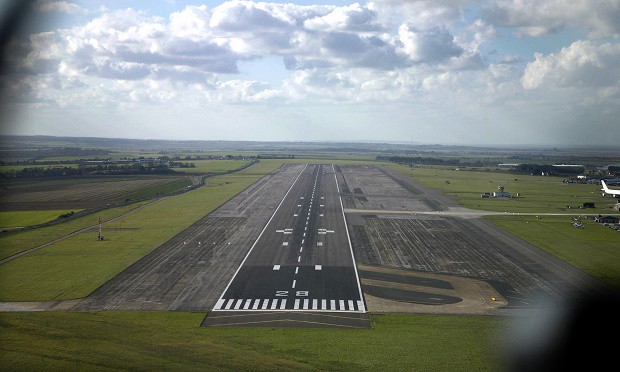
A wrangle over whether a night flight ban would be an absolute ban took place during the latest hearing for a development consent order application for the Manston airport site.
The session held at Discovery Park on Friday (March 22) was to look specifically at noise and vibration associated with plans by RiverOak Strategic Partners to acquire the site through the DCO and create a cargo hub and aviation-related businesses.
The land belongs to Stone Hill Park which has lodged a masterplan application for housing, leisure, business and infrastructure on the site.
The examination process, which includes hearings and site visits, is due for completion in July. A decision on the application will then be made by the Secretary of State,
One issued raised was whether the night time ban on flights actually constituted a full ban.
According to the latest noise mitigation plan submitted by RSP there will be a total annual air transport movement limit of 26,468 with a General Aviation movement limit of 38,000. The proposal is for an annual quota during the Night Time Period (11pm-7am) of 3028 movements.
The site would have an overall operating capability of 83,220 movements per annum.
Night flights
RSP data predicts 33 Air Transport Movements (ATMs) and approximately 16 non ATMs on a typical busy day in all years. In Year 20 there is predicted to be 72 ATMs during a typical busy day and 7.6 ATMs on a typical busy night.
However, RSP Lead Counsel, Isabella Tafur said: “There will be no flights, programmed charted or scheduled” between 11pm and 6am. She then added that delayed flights might land within those hours but there would be no take offs.
Tony Freudmann, of RSP, said delayed flights would be primarily passenger ones that could be scheduled to be back by 10pm but would gain an hour UK time. He used Luton and Stansted as examples.
However, Louise Congdon, of York Aviation LLP and on behalf of SHP, said his timings were wrong and Luton would allow flights to land as late as 11pm until 1am – saying that meant there would be a need for Manston to offer the same service.
Isabella Tafur also admitted inbound freighter flights, with a noisier quota count of 4, could also run late to schedule although no quota 8 and 16 flights – making the most noise – would be allowed to take off or land during the night time period. Flights would be able to operate between 6am-7am – still technically night time hours.
She said: “The will be no flights programmed although there may be some late arrivals that would be accepted at the airport. There will be n departures under any circumstances.
The explanation did not satisfy examining committee lead member who said: “To sum up, there is no ban on night flights, is there?”
Isabella Tafur again reiterated the ‘programmed’ ban on flights between 11pm and 6am.
747s?
Thanet council questioned the 3,028 night flight quota and whether late freight arrivals would include 747 craft – with a 4QC.
Isabella Tafur, told the committee: “Restrictions on night flights are a recent addition to the deadline 4 environmental assessment.” She added that a forecast of how many 747s might arrive late could not be made although the RSP team said it would take away proposals for recording late flights..
During the 6am to 7am period the committee was told any take offs recording over 82 decibels would be subject to fines starting at £750.
Measuring noise disturbance
Measurements in the RSP report say a significant adverse noise level is measured at 63db (decibels) during the day flying period, 55db at night or 80db for more than 18 nightly events.
Anything 69db and over is labelled as an unacceptable level. Aircraft noise is measured by a quota count of Effective perceived noise in decibels (EPNdB).
Lowest is 84 – 86.9 EPNdB with a 0.25 quota count whilst the top end is 96 – 98.9 EPNdB with a quota count of 4; 99 – 101.9 EPNdB quota 8 and anything greater than 101.9 EPNdB equalling a count of 16.
Questions were raised about how potential noise impacts had been measured with RSP basing data on a 16 hour daytime period with Thanet council suggesting 30 minute periods would give a clearer overall picture.
Thanet council said there should be a lower noise threshold as isle residents would be unused to aircraft noise after almost five years of closure.
RSP’s panel responded by saying the measurements were made using the appropriate model.
Thanet council or the Secretary of State?
The issue also led to a dispute over who should be the approving body for agreed noise restrictions. Iain Livingston of Thanet council insisted the local authority should be at the reins whilst RSP said, based on previous actions by TDC, its performance at the House of Commons transport committee in 2014/15 and the current status of the draft Local Plan, the deciding body should be the Secretary of State.
This was questioned by the examining panel who asked whether the the democratic process should be representation of local people by a local authority.
Isabella Tafur said the RSP position was unchanged and TDC could represent local people as a consultee. She added: “Our preference is that the Secretary of State be the discharging body.”
Mr Livingstone retaliated with: “We made our position clear, TDC is more than able to discharge the requirements put forward.”
The next stage of the examination process is deadline 5, on March 29, for submission of documents including written summaries of the most recent hearings.
Public hearings resume in June.

